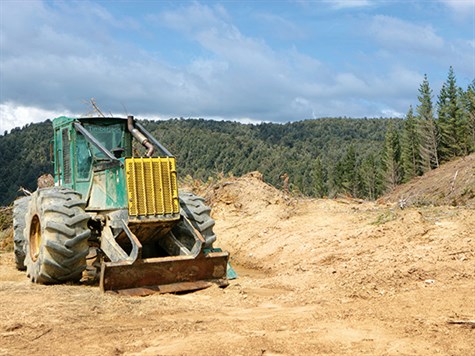Forestry: Rock or trees – what comes first?
As a logger, do you ever spare a thought about the trees you are cutting down and how they got there in the first place?

Radiata Pine trees have been in New Zealand since around 1850. Originally imported from California, the trees suited New Zealand conditions and were used as shelter belts. These first trees grew quite ugly, with plenty of limbs with forked and malformed trunks.
Pinus radiata or Monteray pine is the world's most widely planted soft wood plantation tree. Australia and Chile also grow radiata. In New Zealand, radiata makes up 89 percent of our total forest. It's hard to believe the world has in excess of one trillion trees. This increases in size by ten billion tonnes per year, and as a carbon renewable resource, without it, the world would be dead.
Just to throw a spanner in the works, what is the most important to our economy — rock or wood? In a recent conversation I had, it was put to me that the economy starts at the quarry face. If we are digging rock then everyone will be busy as we need rock for everything — building our roads, making cement, you name it we need rock. But wood is just as important.
When time began, you could not cook a feed on a pile of rocks without fuel. Wood is fuel, you cannot heat the house that rock built without fuel, so I'm putting wood first and rock second. Rock is not a renewable resource and does not contribute to clean air.
So, how did our pine plantation come about? Well, back in 1893, a person called Duncan Rutherford from Leslie Hills Station near Culverden, in the South Island, dropped and milled some twenty-year-old radiata pines and used the timber for farm buildings.
Seeds were gathered from the best trees and nurseries were developed to propagate the seeds. From here, seed orchards were planted, fenced off, and kept at a distance from already standing forest to avoid cross pollination. I always wondered why radiata never had a taproot.
Quite often in a wind-blow situation when trees were blown over, you'd see just a big fan of shallow rooting. Well now I know, the seedlings roots are undercut to encourage more fibrous roots near the surface. This means they've a better chance of survival when planted out.
Interesting to note the number of steps required to grow a tree before you whip your chainsaw out and bring it crashing to the ground, throw it on a truck, and take it to the mill or the port. To produce a good quality tree, land preparation is important, ripping or ploughing the soil or forming mounds, give the young radiata seedling a better chance to grow.
Radiata is a very versatile tree that will grow in the many diverse soil types, from Cape Reinga to the Bluff. Northland grows the densest radiata and the further south you go, the density lessens.
The least popular job in forestry is the silverculture crew, but if we didn't have them, we wouldn't have pine plantations. It's damn hard work walking up and down hills all day with a bag of seedlings on your back and a special spade in hand, planting between six hundred to fourteen hundred trees per hectare.

If you ever get the opportunity to work in silverculture, have a go — it is some of the toughest logging work you will ever do and you'll never look down your nose at this part of the industry ever again.
How easy is it for loggers to forget, or fail to reflect on, all those further down the chain that have worked to produce trees for harvest. Silverculture is so important to the production of our radiata pine, the industry wouldn't survive without these people putting in the hard yards.
Managing plantations involves thinning and pruning, depending on whether the trees are grown for high-value saw logs, or as lower-quality logs. The silverculture crews will eventually thin the numbers down to approximately three hundred stems per hectare. Harvest age will depend on location, starting between twenty-five to thirty-five years.
We all pass logging trucks on our roads and most of us complain, muttering 'damn logging trucks'. But stop and think for a moment — if those trucks don't get the mill, those logs don't get turned into timber and your house doesn't get built. Everything we do on a daily basis requires wood — the paper you put in your printer, your Christmas gift wrapping.
Probably the most important of all, those with wood fires will always be warm in winter. Those that rely on electricity could find themselves very cold when the power goes off, and in the modern day and age that still happens.
There will be those who read this and say, 'You can't get the wood out of the forest without roads', and I guess you're right, so a compromise would be prudent here.
Next time you're driving past a forest, take a little time to reflect how important it is — the country could not survive without it. So much history and hard work has gone into developing sustainable pine plantations.
Never miss an issue. Subscribe to Deals on Wheels magazine here.
Keep up to date in the industry by signing up to Deals on Wheels' free newsletter or liking us on Facebook.

.jpg)

.jpg)

.jpg)

